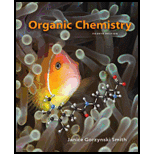
Concept explainers
Interpretation: The compound
Concept introduction: The electron withdrawing or electron releasing groups have a significant role in the activation and deactivation of benzene rings during an electrophilic aromatic substitution reaction. An electron withdrawing group deactivates the benzene rings by reducing the electron density on the rings.The electrophilic groups tend to accept or withdraw the electrons from the rest of the compound.The deactivating groups are those groups that tend to withdraw the electron density from the benzene ring and decrease the overall
Trending nowThis is a popular solution!

Chapter 19 Solutions
Organic Chemistry
- Eleostearic acid, C18H30O2, is a rare fatty acid found in the tung oil used for finishing furniture. On ozonolysis followed by treatment with zinc, eleostearic acid furnishes one part pentanal, two parts glyoxal (OHC-CHO), and one part 9-oxononanoic acid [OHC(CH2)7CO2H]. What is the structure of eleostearic acid?arrow_forwardOne frequently used method for preparing methyl esters is by reaction of carboxylic acids with diazomethane, CH2N2. The reaction occurs in two steps: (l) protonation of diazomethane by the carboxylic acid to yield methyldiazonium ion, CH3N2+, plus a carboxylate ion; and (2) reaction of the carboxylate ion with CH3N2+. (a) Draw two resonance structures of diazomethane, and account for step 1. (b) What kind of reaction occurs in step 2?arrow_forwardThioglycolic acid, HSCH2CO2H, a substance used in depilatory agents (hair removers) has pKa = 3.42. What is the percent dissociation of thioglycolic acid in a buffer solution at pH = 3.0?arrow_forward
- The following pKa values have been measured. Explain why a hydroxyl group in the para position decreases the acidity while a hydroxyl group in the meta position increases the acidity.arrow_forwardDihydropyran is synthesized by treating tetrahydrofurfuryl alcohol with an arenesulfonic acid, ArSO3H. Propose a mechanism for this conversion.arrow_forwardClaisen condensation between diethyl phthalate and ethyl acetate followed by saponification, acidification, and decarboxylation forms a diketone, C9H6O2. Propose structural formulas for compounds A and B and the diketone.arrow_forward
- Draw a resonance structure of the acetonitrile anion, :CH2C =N, and account for the acidity of nitriles.arrow_forwardSubstituted phenols show substituent effects similiar to substituted benzoic acids. Should the pKa of phenol A, one of the naturally occurring phenols called urushiols isolated from poison ivy, be higher or lower than the pKa of phenol (C6H5OH, pKa = 10)? Explain.arrow_forwardElectrophilic aromatic substitution usually occurs at the 1-position of naphthalene, also called the a position. Predict the major products of the reactions of naphthalene with the following reagents.(a) isobutylene and HF (b) cyclohexanol and BF3 (c) fuming sulfuric acidarrow_forward

 Organic ChemistryChemistryISBN:9781305580350Author:William H. Brown, Brent L. Iverson, Eric Anslyn, Christopher S. FootePublisher:Cengage Learning
Organic ChemistryChemistryISBN:9781305580350Author:William H. Brown, Brent L. Iverson, Eric Anslyn, Christopher S. FootePublisher:Cengage Learning

